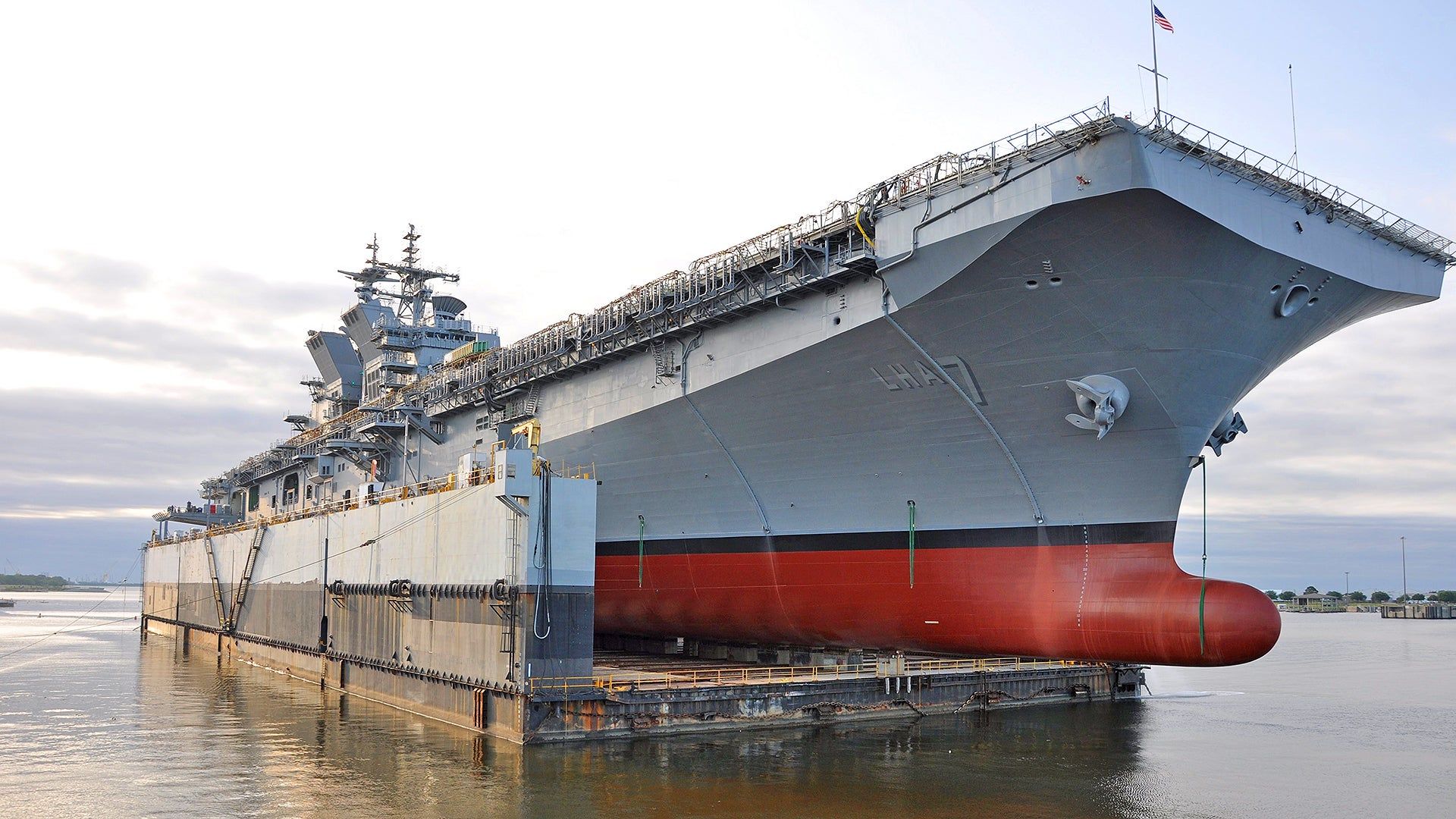Navy's New 381-Hull Fleet Plan Recommits To Big Amphibious Warfare Ships
The U.S. Navy says it has reaffirmed its need for at least 31 large amphibious warships in the future in a classified report, which was recently sent to Congress. Earlier this year, the service announced its desire to institute a “strategic pause” on ordering new amphibious ships, specifically, which led to an unusually public spat with the U.S. Marine Corps and pushback from lawmakers. Questions about its new assessment, which also lays out plans for eventually having a total fleet consisting of 381 ships and submarines, remain, especially given long-standing concerns about U.S. shipbuilding capacity.
USNI News was the first to report on the new Battle Force Ship Assessment and Requirement report. The Navy is currently required to deliver one of these reviews annually to Congress and sent its first one to legislators last year.
A trio of US Navy amphibious warfare ships: the amphibious assault ship USS Wasp (at left), the landing platform dock ship USS San Antonio (at bottom right), and the landing ship dock USS Whidbey Island (at top right). USN
“The analytics-based report determined a future battle force objective of 381 ships is required to meet future campaigning and warfighting demands,” the Navy told USNI News in a statement. "This report supports the 2022 National Defense Strategy and will inform future budget submissions and force structure requirements. The 2023 BFSAR reinforces the need for a larger, more capable, more distributed naval force."
The Navy uses the term "battle force" to refer collectively to its fleets of major surface warships, submarines, and large auxiliaries. The 2022 iteration of this report to Congress, which was also classified, laid out a requirement for a battle force with 373 vessels in total. The service currently expects the size of its battle force in the 2024 Fiscal Year to be 293 vessels, including 29 amphibious warfare ships. That portion of its force will include America and Wasp class amphibious assault ships, San Antonio class landing platform dock (LPD) ships, and Whidbey Island and Harpers Ferry class dock landing ships (LSD).
It's also worth noting that the 381 and 373 figures both do not include uncrewed ships and submarines. The Navy has said in the past that expects to acquire around 150 uncrewed platforms of various types in the coming years, some of which will be relatively large.
Two large uncrewed surface vessels that the Navy has been using for various test and evaluation purposes. USN
Further details about the new overall assessment are limited and the service does not currently plan to release an unclassified version, according to USNI News. "A classified report enables the Navy to share greater insights and information about force structure requirements and the composition of our Navy," the service added in its statement to that outlet.
However, the Navy did confirm that the new battle force requirement includes 31 amphibious warfare ships as a "future objective." This is very significant given the fallout from the service's previously stated plans to curtail amphibious ship procurement.
In February, Secretary of the Navy Carlos Del Toro said there was a need for a "strategic pause" in purchasing new large amphibious warfare vessels. The following month, the service released its proposed Fiscal Year 2024 budget request, which axed a previously planned purchase of a San Antonio class amphibious warfare ship. It also revealed that the Navy no longer had any intention of buying any additional San Antonios for at least another five years. This, in turn, would mean no plans for one-for-one replacements of older Whidbey Island and Harpers Ferry class amphibious warfare vessels that are still slated to be decommissioned.
The San Antonio class USS New York, at left, and the Harpers Ferry class USS Oak Hill, at right, replenish at sea from the Lewis and Clark class dry cargo and ammunition ship USNS William McLean, at center. USN
This quickly created immense friction between the Navy and the Marine Corps, which relies heavily on Navy amphibious ships to conduct its core missions. The Corps has been unusually publicly outspoken in its opposition to the Navy's proposed course of action.
“This budget proposes early decommissioning of three of those LSDs with no construction or acquisition of an LPD. For my role as defining what the requirements are – the statutory minimum of 31 – there’s no plan to get there," now-retired Marine Gen. David Berger, who was the service's top officer at the time, told members of Congress at a hearing in March. "From my perspective... There’s no plan to get to the minimum requirements."
“Without a programmed replacement for LSD’s being decommissioned, substantial risk falls on the Combatant Commander as the requirement for 31 ships will not be met," Maj. Josh Benson, a Marine Corps spokesperson, also told USNI News that month. "This is unacceptable.”
“We didn't have a Marine Expeditionary Unit, a MEU, nearby that could respond… I owe the Secretary of Defense, the President – we joint chiefs owe them options… all the time," Gen. Berger said in an interview with Defense One in February about the situation in Turkey specifically. "Here, I felt like the best option, we couldn't offer them because we have the Marines and the equipment and they're trained, we didn't have the ships."
Despite "healthy friction" over the LSM, "there is no daylight between us" on the need for those ships, Navy Vice Adm. Scott Conn, Deputy Chief of Naval Operations for Warfighting Requirements and Capabilities, said at a conference in April.
All this being said, significant questions about the Navy's current 381-ship battle force plan and its amphibious warfare component remain, including how the service expects to reach its goals and when.
In March, the Navy sent its latest unclassified long-range shipbuilding plan to Congress and released copies to the media, including The War Zone. That document outlines three courses of action, seen below, but none of them show the service reaching a battle force with 381 vessels by Fiscal Year 2053, the last year in the outlays. The most optimistic course of action would see the Navy's battle force grow to 367 hulls, but only 23 of those would be amphibious warfare ships. Not one of the proposals shows the service getting above 30 amphibious ships in the next three decades.
USN
Without having the complete details of the new classified plan, all this can only raise questions about when exactly the Navy expects to meet its "future objective" of having 31 amphibious warfare ships or its full 381-ship battle force.
A particularly glaring issue for these plans, overall, is the limitations of U.S. shipbuilding capacity. An unclassified briefing slide from the Office of Naval Intelligence, reproduced below, recently emerged that highlights the exponentially larger size of the Chinese shipbuilding industry. Chinese shipbuilders are estimated to be more than 200 times more capable of building various vessels, including warships and submarines, than their American counterparts, as you can read more about here.
USN
Shipbuilding is a notably long-lead endeavor that requires the establishment and maintenance of large and specialized supply chains, as well as significant amounts of skilled labor.
"Depending on the length of a strategic pause, it risks the complete shutdown of a line. If a shipbuilding line shuts down, the risk to meeting future requirements greatly increases," Marine Maj. Benson, the spokesperson for that service, had warned when speaking to USNI News earlier this year. "Shipyards will be forced to cut workforce personnel. These losses will include skilled labor with years of experience that have been carried forward from keel to keel."
There is also the question of how the Navy expects to pay for what it will take to get to its 381-ship goal, particularly maintaining a force of 31 large amphibious warfare ships while planning to buy a similar number of additional LSMs. Back in 2019, Marine Corps Commandant Berger himself had appeared supportive of cuts to the total number of traditional amphibious warfare ships and had been critical of what he described as "heavily investing in expensive and exquisite capabilities that regional aggressors have optimized their forces to target."
All of this will translate into higher operating costs, as well. Back in 2019, the Navy itself acknowledged that its plans then for growing its battle force to just 355 ships would increase its annual sustainment costs by 30 percent, to $40 billion a year.
The Navy already struggles to meet its current maintenance demands. Its submarine forces have been particularly hard hit. As of November 2022, around 36 percent of its attack submarines of all classes were undergoing or awaiting repairs or overhauls. The goal has been to have no more than 20 percent of attack submarines sidelined for these reasons at any one time.
Altogether, it is certainly important that the Navy has re-committed to having a fleet that includes 31 amphibious warfare ships in the future. At the same time, it very much remains to be seen how the service plans to achieve that specific goal, as well as its overarching 381-ship plan, and when.
Source: The War Zone


